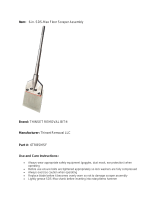Page is loading ...

WWW.SOLISTONE.COM
INFORMATION & GUIDELINES FOR THE INSTALLATION OF TERRENE PORCELAIN
RECOMMENDED INSTALLATION
SOLISTONE Terrene porcelain mosaics are not recommended for areas that may be subject to
heavy impact, heavy abrasion, and areas where temperatures can exceed 130 degrees
Fahrenheit. This product is suitable for wet and dry applications, interior and exterior walls, and
light traffic pedestrian floors only.
NOTE: this document contains only guidelines for the installation process. A professional installer
should always be consulted to discuss the specific parameters surrounding your project.
SUBSTRATES
All substrates should be firmly fixed, flat, clean, dry and free of contaminants such as dust, oil,
paint, sealers etc. to ensure proper adhesion. Painted surfaces must be scuffed or sanded for the
product and adhesive to bond correctly. Wet areas need special attention and require
appropriate substrates, e.g. concrete, cement boards (compressed sheet), and/or treated
plywood. The use of reinforced waterproof membranes is suggested.
WATERPROOF MEMBRANES
Waterproof membranes prevent leakage of water through to the sub-floor framing and/or
habitable spaces below. Particular attention must be paid to: carrying the membrane up the wall,
outside shower boxes, installation of bond breakers, and sealing around penetrations. It is
strongly recommended that membrane systems be used in all wet areas. Some systems may
involve the use of a primer.
CUTTING
Cuts can be done with either a wet saw or the tiles can be scored and snapped. To cut with a wet
saw, tape the area around the desired cut with masking or painter’s tape and run the saw through
the tape. Remove tape after cut is made. This will create a clean, straight edge and avoid
chipping the glaze.
The mesh back can easily be cut with a utility knife. To create a flush edge or corner, pull excess
pieces from the mesh and cut to straight edge. Then, replace in thinset and continue the grouting
process.
ADHESIVE
Follow the adhesive manufacturer’s instructions carefully. We do not recommend one brand of
adhesive over another. Please check with your local tile supply store for alternative and
comparable products.
The manufacturer's literature will explain if the adhesive product is suitable for interiors and/or
exteriors, as well as walls and floors. Most thinset mortars with a latex additive (multi purpose
and polymer modified thinsets) are adequate for installing this glass and marble combination. A

WWW.SOLISTONE.COM
cement-based adhesive is generally suitable on masonry substrates where no movement is
anticipated. Where slight movement could occur through thermal or pedestrian loads, a modified
cement adhesive should be used as a minimum. A 1/4” – 1/8” notch trowel is recommended for
most applications. Set the tile in place gently tapping it in with a grout float to ensure 100%
adhesive coverage.
GROUTING
Select the type of grout you use based on the width of the desired joint. Sanded grout is
generally recommended for any grout joint larger than 1/8”. Grouts are ordinarily a water mix
but where some flexibility may be needed, a latex additive or similar product should be used.
SEALANTS
The porcelain tiles do not have to be sealed but we strongly recommend sealing the grout after
installation to help prevent it from absorbing stains.
CARE & CLEANING
Terrene porcelain mosaics must be regularly cleaned and maintained to extend the life and
beauty of the installation. The tiles can be cleaned with a neutral mild detergent or glass cleaner.
Any spills should be cleaned quickly to lessen the degree of the stain to the grout. Do not use
abrasive cleaners, powders, scouring pads, steel wool or sandpaper.
/



